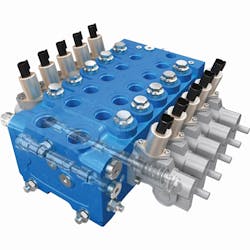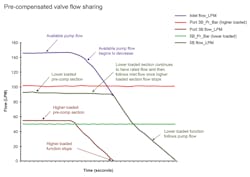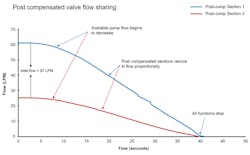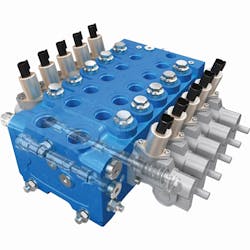Pre- or Post-Compensation: The Days of “or” are Over
The machine design process has traditionally been full of sacrifices and trade-offs: one option selected at the expense of another. However, the tides are changing with the help of new solutions that are advancing the way we build machines. With innovation in load-sensing technologies and new mobile valve solutions, there is a broader range of configuration options available today.
The dynamics surrounding hydraulic flow control while multi-servicing help to illustrate how the design process has changed. Historically, there have been two options to maintain load control when the pump becomes saturated during multi-service conditions: pre-compensation or post-compensation. While these options used to be mutually exclusive, new mobile valves offer machine designers an opportunity to leverage the benefits of both functionalities.
In this article, we will outline the differences between pre- and post-compensation, as well as provide an overview of the advantages surrounding each method. We will also explore what it means to combine the two options in a single valve bank, and the advantages that bring to mobile machinery.
Background and Benefits
Hydraulic pumps use load-sensing technology to generate the right amount of power at the right time. Load-sensing systems detect the load-induced pressure at the actuator and communicate that pressure to the pump to increase or decrease both pressures and flow as needed, thus optimizing efficiency and minimizing energy loss. While these systems help keep a single motor or cylinder running efficiently, there are challenges for users when it comes to dealing with saturation in the pump.
Traditional load-sensing systems maintain consistent operation speeds through pressure compensation: either pre-compensation or post-compensation. Pre-compensation maintains consistent flow from each section of the valve, even when the pump pressure fluctuates due to multi-servicing, but each function is blind to what all other functions are doing.
Each section attempts to utilize 100% of the flow demanded by the user. As a consequence, when there is no longer enough pump flow available to satisfy the movement of all active services—a condition known as pump saturation—the service with the highest load (highest pressure) slows down or stops. This action results in a slowing or loss of movement on functions with higher induced loads until the flow available from the pump exceeds the flow requested from all of the functions.
Flow Sharing (pre-compensated valves): flow vs. time.
While pre-compensation may be enough to accomplish the vehicle’s intended purpose, post-compensation can help ensure no vital functions are left without control. Post-compensation maintains consistent flow from each section of the valve, even when the pump pressure fluctuates due to multi-servicing, but each section is aware of the loads outside of itself. When the pump saturates, the flow of oil from all sections or functions is decreased proportionally, resulting in a slowing or reduced speed of performance, but no loss in function. All functions share the flow and all services slow down. Valves built using post-compensation are often referred to as flow sharing valves.
Flow sharing (post-compensated valves): flow vs. time.
Load-sensing valves traditionally haven’t enabled the prioritization of specific functions within the system. Most hydraulic valves enforce a binary choice, as most are equipped with either pre-compensation or post-compensation. Unfortunately, going with one option over the other could result in a negative impact on productivity, regardless of the benefits they bring to the table.
A New Horizon
Today’s innovative valve solutions can combine the distinct approaches to pressure compensation. By bringing pre- and post-compensated sections together in the same valve, a new solution is created: priority flow sharing. This combination allows machine designers to maintain priority flow to the function of choice by assigning a pre-compensation section to that function, while all other functions get post-compensation sections. The post-compensated sections share the pump flow that remains after the priority section gets all the flow it demands. The result is hydraulic functions that remain uncompromised under saturation conditions.
With this type of advanced load-sensing valve platform, operators gain better control of their machines and can better manage work functions and safety as they deal with saturation conditions in the pump. This can help keep machines hauling, loading, drilling, and moving, even when faced with saturation conditions.
For example, the new Eaton CLS load sense sectional mobile valve offers an advanced version of this configuration. By providing for pre- and post-compensation in a single valve, plus the ability to configure and control, valves like the CLS can be a valuable option for machine designers that require versatility in their applications.
Eaton’s CLS 100 load sensing sectional mobile valves are a pre- and post-compensated mobile valve family with a highly versatile design.
The Bottom Line
Designers of off-highway equipment such as construction and agricultural machinery are calling for more flexible configuration options in the ongoing quest to improve reliability and performance, all the while maintaining the efficiency load sensing has enabled. Meeting these objectives drills down to the hydraulic valves deployed, and how they address challenges in areas like pump saturation.
Thankfully, mobile valves are advancing in a way that aligns with industry demands. Priority flow sharing is one-way manufacturers have answered the call, offering a more robust solution to deploy in hydraulic systems. In many cases, the ability to intelligently design a priority flow sharing valve enables machine designers to reduce the size of the pump and engine, saving money and boosting efficiency.
With the advancement of mobile valve solutions and related technology, OEMs will continue to design and deliver smarter machines—ones that can intelligently adapt and respond to changing demands and conditions for today’s users.
Stephen Smith is an engineering manager and Robin Ireton is a lead engineer with Eaton’s Hydraulics Group.




